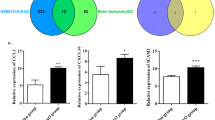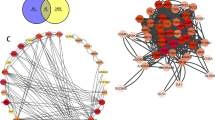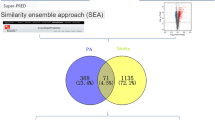Abstract
Medicarpin, a pterocarpan class of naturally occurring phytoestrogen possesses various biological functions. However, the effect of medicarpin on oxygen-glucose deprivation-reoxygenation (OGD/R)-induced injury in human cerebral microvascular endothelial cells (HCMECs) remains largely unknown. Target genes of medicarpin were predicted from PharmMapper. Target genes of ischemic stroke were predicted from public databases GeneCards and DisGeNET. Kyoto Encyclopedia of Genes and Genomes pathway enrichment of the intersecting targets was analyzed via DAVID 6.8. Cell viability was evaluated using CCK-8 assay. Malondialdehyde content, superoxide dismutase activity, and glutathione level were detected using corresponding commercially available kits. Cell death was assessed by TUNEL assays. Expression of protein kinase B (Akt), phosphorylated-Akt, forkhead box protein O1, phosphorylated-FoxO1, FoxO3a, and phosphorylated-FoxO3a (p-FoxO3a) was detected by western blot analysis. The intersecting targets of medicarpin and ischemic stroke were significantly enriched in phosphatidylinositol 3-kinase (PI3K)/Akt and FoxO pathways. Medicarpina attenuated OGD/R-evoked viability inhibition, oxidative stress, and cell death in HCMECs. Additionally, medicarpin activated the PI3K/Akt and FoxO pathways in OGD/R-induced HCMECs. Inhibition of PI3K/Akt pathway abrogated the neuroprotective effect of medicarpin on OGD/R-induced injury and activation of FoxO pathway in HCMECs. In conclusion, medicarpin suppressed OGD/R-induced injury in HCMECs by activating PI3K/Akt/FoxO pathway.







Similar content being viewed by others
Data Availability
The datasets used and analyzed during the current study are available from the corresponding author on reasonable request.
References
Benjamin EJ, Virani SS, Callaway CW, Chamberlain AM, Chang AR, Cheng S, Chiuve SE, Cushman M, Delling FN, Deo R, de Ferranti SD, Ferguson JF, Fornage M, Gillespie C, Isasi CR, Jiménez MC, Jordan LC, Judd SE, Lackland D, Lichtman JH, Lisabeth L, Liu S, Longenecker CT, Lutsey PL, Mackey JS, Matchar DB, Matsushita K, Mussolino ME, Nasir K, O’Flaherty M, Palaniappan LP, Pandey A, Pandey DK, Reeves MJ, Ritchey MD, Rodriguez CJ, Roth GA, Rosamond WD, Sampson UKA, Satou GM, Shah SH, Spartano NL, Tirschwell DL, Tsao CW, Voeks JH, Willey JZ, Wilkins JT, Wu JH, Alger HM, Wong SS, Muntner P (2018) Heart disease and stroke statistics-2018 update: a report from the American Heart Association. Circulation 137:e67–e492
Donnan GA, Fisher M, Macleod M, Davis SM (2008) Stroke. Lancet 371:1612–1623
Mensah GA, Norrving B, Feigin VL (2015) The global burden of stroke. Neuroepidemiology 45:143–145
Karl JM, Alaverdashvili M, Cross AR, Whishaw IQ (2010) Thinning, movement, and volume loss of residual cortical tissue occurs after stroke in the adult rat as identified by histological and magnetic resonance imaging analysis. Neuroscience 170:123–137
Campbell BC, Mitchell PJ, Kleinig TJ, Dewey HM, Churilov L, Yassi N, Yan B, Dowling RJ, Parsons MW, Oxley TJ, Wu TY, Brooks M, Simpson MA, Miteff F, Levi CR, Krause M, Harrington TJ, Faulder KC, Steinfort BS, Priglinger M, Ang T, Scroop R, Barber PA, McGuinness B, Wijeratne T, Phan TG, Chong W, Chandra RV, Bladin CF, Badve M, Rice H, de Villiers L, Ma H, Desmond PM, Donnan GA, Davis SM (2015) Endovascular therapy for ischemic stroke with perfusion-imaging selection. N Engl J Med 372:1009–1018
Moskowitz MA, Lo EH, Iadecola C (2010) The science of stroke: mechanisms in search of treatments. Neuron 67:181–198
Gomis M, Dávalos A (2014) Recanalization and reperfusion therapies of acute ischemic stroke: what have we learned, what are the major research questions, and where are we headed? Front Neurol 5:226
Ingham JL, Harborne JB (1976) Phytoalexin induction as a new dynamic approach to the study of systematic relationships among higher plants. Nature 260:241–243
Imran KM, Yoon D, Lee TJ, Kim YS (2018) Medicarpin induces lipolysis via activation of protein kinase A in brown adipocytes. BMB Rep 51:249–254
Trivedi R, Maurya R, Mishra DP (2014) Medicarpin, a legume phytoalexin sensitizes myeloid leukemia cells to TRAIL-induced apoptosis through the induction of DR5 and activation of the ROS-JNK-CHOP pathway. Cell Death Dis 5:e1465
Gatouillat G, Magid AA, Bertin E, El btaouri H, Morjani H, Lavaud C, Madoulet C (2015) Medicarpin and millepurpan, two flavonoids isolated from Medicago sativa, induce apoptosis and overcome multidrug resistance in leukemia P388 cells. Phytomedicine 22:1186–1194
Mansoori MN, Raghuvanshi A, Shukla P, Awasthi P, Trivedi R, Goel A, Singh D (2020) Medicarpin prevents arthritis in post-menopausal conditions by arresting the expansion of TH17 cells and pro-inflammatory cytokines. Int Immunopharmacol 82:106299
Culmsee C, Zhu C, Landshamer S, Becattini B, Wagner E, Pellecchia M, Blomgren K, Plesnila N (2005) Apoptosis-inducing factor triggered by poly(ADP-ribose) polymerase and bid mediates neuronal cell death after oxygen-glucose deprivation and focal cerebral ischemia. J Neurosci 25:10262–10272
Meng L, Lin J, Huang Q, Liang P, Huang J, Jian C, Lin C, Li X (2019) Panax notoginseng saponins attenuate oxygen-glucose deprivation/reoxygenation-induced injury in human SH-SY5Y cells by regulating the expression of inflammatory factors through miR-155. Biol Pharm Bull 42:462–467
Zhang K, Yang Y, Ge H, Wang J, Chen X, Lei X, Zhong J, Zhang C, Xian J, Lu Y, Tan L, Feng H (2020) Artesunate promotes the proliferation of neural stem/progenitor cells and alleviates Ischemia-reperfusion Injury through PI3K/Akt/FOXO-3a/p27(kip1) signaling pathway. Aging 12:8029–8048
Militão GC, Dantas IN, Pessoa C, Falcão MJ, Silveira ER, Lima MA, Curi R, Lima T, Moraes MO, Costa-Lotufo LV (2006) Induction of apoptosis by pterocarpans from Platymiscium floribundum in HL-60 human leukemia cells. Life Sci 78:2409–2417
Ghribi L, Waffo-Téguo P, Cluzet S, Marchal A, Marques J, Mérillon JM, Ben Jannet H (2015) Isolation and structure elucidation of bioactive compounds from the roots of the Tunisian Ononis angustissima L. Bioorg Med Chem Lett 25:3825–3830
Fisher M, Saver JL (2015) Future directions of acute ischaemic stroke therapy. Lancet Neurol 14:758–767
Xin JW, Jiang YG (2017) Long noncoding RNA MALAT1 inhibits apoptosis induced by oxygen-glucose deprivation and reoxygenation in human brain microvascular endothelial cells. Exp Ther Med 13:1225–1234
Huang S, Gong T, Zhang T, Wang X, Cheng Q, Li Y (2019) Zhongfenggao protects brain microvascular endothelial cells from oxygen-glucose deprivation/reoxygenation-induced injury by angiogenesis. Biol Pharm Bull 42:222–230
Kim SK, Lee S, Lee MK, Lee S (2019) A systems pharmacology approach to investigate the mechanism of Oryeong-san formula for the treatment of hypertension. J Ethnopharmacol 244:112129
Zeng L, Yang K (2017) Exploring the pharmacological mechanism of Yanghe Decoction on HER2-positive breast cancer by a network pharmacology approach. J Ethnopharmacol 199:68–85
Ramos E, Patiño P, Reiter RJ, Gil-Martín E, Marco-Contelles J, Parada E, de Los RC, Romero A, Egea J (2017) Ischemic brain injury: new insights on the protective role of melatonin. Free Radic Biol Med 104:32–53
Shaw RJ, Cantley LC (2006) Ras, PI(3)K and mTOR signalling controls tumour cell growth. Nature 441:424–430
Zhao S, Fu J, Liu X, Wang T, Zhang J, Zhao Y (2012) Activation of Akt/GSK-3beta/beta-catenin signaling pathway is involved in survival of neurons after traumatic brain injury in rats. Neurol Res 34:400–407
Tu XK, Zhang HB, Shi SS, Liang RS, Wang CH, Chen CM, Yang WZ (2016) 5-LOX inhibitor zileuton reduces inflammatory reaction and ischemic brain damage through the activation of PI3K/Akt signaling pathway. Neurochem Res 41:2779–2787
Wang Y, Zhang J, Han M, Liu B, Gao Y, Ma P, Zhang S, Zheng Q, Song X (2016) SMND-309 promotes neuron survival through the activation of the PI3K/Akt/CREB-signalling pathway. Pharm Biol 54:1982–1990
Ma Y, Lu C, Li C, Li R, Zhang Y, Ma H, Zhang X, Ding Z, Liu L (2013) Overexpression of HSPA12B protects against cerebral ischemia/reperfusion injury via a PI3K/Akt-dependent mechanism. Biochim Biophys Acta 1832:57–66
Williams DL, Ozment-Skelton T, Li C (2006) Modulation of the phosphoinositide 3-kinase signaling pathway alters host response to sepsis, inflammation, and ischemia/reperfusion injury. Shock 25:432–439
Gomes AR, Brosens JJ, Lam EW (2008) Resist or die: FOXO transcription factors determine the cellular response to chemotherapy. Cell Cycle 7:3133–3136
Yang JY, Hung MC (2009) A new fork for clinical application: targeting forkhead transcription factors in cancer. Clin Cancer Res 15:752–757
Li W, Zhu Q, Xu X, Hu X (2021) MiR-27a-3p suppresses cerebral ischemia-reperfusion injury by targeting FOXO1. Aging 13:11727–11737
Shi WZ, Tian Y, Li J (2019) GCN2 suppression attenuates cerebral ischemia in mice by reducing apoptosis and endoplasmic reticulum (ER) stress through the blockage of FoxO3a-regulated ROS production. Biochem Biophys Res Commun 516:285–292
Tan J, Luo J, Meng C, Jiang N, Cao J, Zhao J (2021) Syringin exerts neuroprotective effects in a rat model of cerebral ischemia through the FOXO3a/NF-κB pathway. Int Immunopharmacol 90:107268
Author information
Authors and Affiliations
Contributions
TW conceived and designed this study. YW conducted the experiments and wrote the manuscript. RY collected the data. FY performed the bioinformatics analysis. YJ analyzed the results. XL conducted the experiments and analyzed the results. All authors read and approved the final manuscript.
Corresponding author
Ethics declarations
Conflict of interest
All authors stated that they have no conflict of interest.
Additional information
Publisher's Note
Springer Nature remains neutral with regard to jurisdictional claims in published maps and institutional affiliations.
Supplementary Information
Below is the link to the electronic supplementary material.
Rights and permissions
About this article
Cite this article
Wang, Y., Yang, R., Yan, F. et al. Medicarpin Protects Cerebral Microvascular Endothelial Cells Against Oxygen-Glucose Deprivation/Reoxygenation-Induced Injury via the PI3K/Akt/FoxO Pathway: A Study of Network Pharmacology Analysis and Experimental Validation. Neurochem Res 47, 347–357 (2022). https://doi.org/10.1007/s11064-021-03449-0
Received:
Revised:
Accepted:
Published:
Issue Date:
DOI: https://doi.org/10.1007/s11064-021-03449-0




